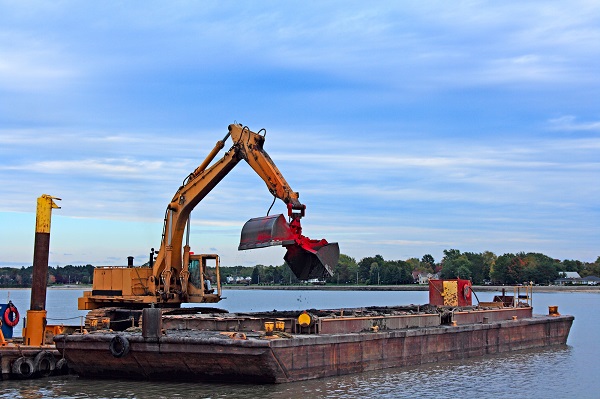Dredging vessels, or dredgers, play a vital role in today’s maritime industry. Dredgers are used to remove sediments and debris from the bottom of lakes, rivers, harbors, and other bodies of water. This is important to keeping a waterway safe for navigation. Without regular dredging, many of America’s naturally shallow waterways would be inaccessible to large oceangoing vessels.

In addition, dredges can be used to replenish beach sands that have undergone extensive erosion, mining and excavation projects, creating new harbors and containing environmental pollution.
Dredging is often controversial because of the harmful effects it has on the marine environment. Dredging accidents also can lead to serious worker injuries. However, in many situations it is the only option for keeping a waterway open to traffic.
Types of Dredging Vessels
There are two main types of dredgers: mechanical and hydraulic.
Mechanical dredges do the job by “hand-packing.” This involves using a crane and bucket to reach down and scoop up the material and then deposit it for disposal. These include:
Hydraulic dredges dislodge the sediments and raise them to the surface in a suspended form using a pumping system. Hydraulic dredges include:
Why Is Working Aboard a Dredger So Dangerous?
The crews working aboard a dredging vessel face many of the same accident risks as crew aboard other vessels.
Some commonly occurring accidents include:
Accidents with the dredger itself could include:
The cranes, buckets, hydraulic pumps and other large, powerful heavy equipment employed to dredge up the sediment present their own hazards as well.
Preventing Dredging Accidents
Even though they may be working in a river, lake or shallow inlet, dredgers must be as seaworthy as any other vessel.
To avoid dredging accidents, vessel owners and crews need to ensure:
Common Injuries Suffered In Dredging Accidents
Dredging accident injuries can be serious, even fatal. Some examples of injuries experienced as a result of dredge accidents include:
Have You Been Injured in a Maritime Accident?
If you’ve been injured in a maritime accident aboard a dredger that happened due to the unseaworthiness of the vessel or other kind of negligence, the Jones Act and other maritime laws give you the right to seek compensation for the damages caused by your injuries.
Lambert Zainey has been protecting the rights of injured maritime workers for over 40 years. We’ve helped dredger crewmembers and other maritime workers obtain the compensation they deserve after being injured in an on-the-job accident that never should have happened.
You only have a limited time in which to act. Contact Lambert Zainey today to speak with an experienced dredger accident lawyer about your claim. Lambert Zainey is headquartered in New Orleans, but we represent maritime workers injured in accidents all across the U.S.
Dredging vessels, or dredgers, play a vital role in today’s maritime industry. Dredgers are used to remove sediments and debris from the bottom of lakes, rivers, harbors, and other bodies of water. This is important to keeping a waterway safe for navigation. Without regular dredging, many of America’s naturally shallow waterways would be inaccessible to large oceangoing vessels.

In addition, dredges can be used to replenish beach sands that have undergone extensive erosion, mining and excavation projects, creating new harbors and containing environmental pollution.
Dredging is often controversial because of the harmful effects it has on the marine environment. Dredging accidents also can lead to serious worker injuries. However, in many situations it is the only option for keeping a waterway open to traffic.
Types of Dredging Vessels
There are two main types of dredgers: mechanical and hydraulic.
Mechanical dredges do the job by “hand-packing.” This involves using a crane and bucket to reach down and scoop up the material and then deposit it for disposal. These include:
Hydraulic dredges dislodge the sediments and raise them to the surface in a suspended form using a pumping system. Hydraulic dredges include:
Why Is Working Aboard a Dredger So Dangerous?
The crews working aboard a dredging vessel face many of the same accident risks as crew aboard other vessels.
Some commonly occurring accidents include:
Accidents with the dredger itself could include:
The cranes, buckets, hydraulic pumps and other large, powerful heavy equipment employed to dredge up the sediment present their own hazards as well.
Preventing Dredging Accidents
Even though they may be working in a river, lake or shallow inlet, dredgers must be as seaworthy as any other vessel.
To avoid dredging accidents, vessel owners and crews need to ensure:
Common Injuries Suffered In Dredging Accidents
Dredging accident injuries can be serious, even fatal. Some examples of injuries experienced as a result of dredge accidents include:
Have You Been Injured in a Maritime Accident?
If you’ve been injured in a maritime accident aboard a dredger that happened due to the unseaworthiness of the vessel or other kind of negligence, the Jones Act and other maritime laws give you the right to seek compensation for the damages caused by your injuries.
Lambert Zainey has been protecting the rights of injured maritime workers for over 40 years. We’ve helped dredger crewmembers and other maritime workers obtain the compensation they deserve after being injured in an on-the-job accident that never should have happened.
You only have a limited time in which to act. Contact Lambert Zainey today to speak with an experienced dredger accident lawyer about your claim. Lambert Zainey is headquartered in New Orleans, but we represent maritime workers injured in accidents all across the U.S.







